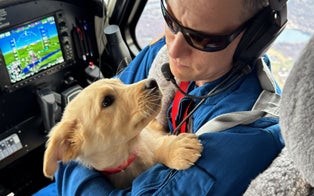The shallow graves are too close to lakes and rivers raising fears of possible contamination of the country’s water supply and prompting calls from local officials to cremate the mink carcasses.
Thousands of mink carcasses infected with a mutated strain of COVID-19 and buried in mass graves in Denmark appear to be emerging from the shallow pits raising fears of possible contamination of the country’s water supply and prompting calls from local officials to cremate the mink carcasses.
“As the bodies decay, gases can be formed,” Danish police spokesman Thomas Kristensen, told the state broadcaster DR, reported The Guardian. “This causes the whole thing to expand a little. In this way, in the worst cases, the mink get pushed out of the ground.”
Earlier this month, thousands of mink were buried in a mass grave that was just over three feet deep on a military training field in the West Jutland region, an area with many confirmed COVID-19 cases connected to minks. Since remains of the creatures have surfaced, officials now plan to bury the minks in graves nearly double the original depths, USA Today reported.
The ministry said the remains were a "temporary problem tied to the animals' decaying process. A fence will be put up and the area and will be monitored 24 hours a day, to avoid potential problems, CBS News reported.
Another major concern among local officials is where the animals are buried. Some say the remains are too close to lakes and underground water reserves, raising fears of possible contamination of ground and drinking water supplies, according to The Guardian.
“It seems like no one really knows the consequences of this,” water official Susan Munster of the Danish water board told Jyllans-Posten. “I must confess I find it worrying.”
Munster said at least two local mayors have demanded the mink remains be incinerated.
Local politician Leif Brogger told the newspaper: “The authorities are playing with our environment, and using it as a dumping ground.”
The issue has enflamed social media, as photos and videos of the mass burial site appeared online. One Twitter user called 2020 "the year of the zombie mutant killer minks."
Denmark's Prime Minister Mette Frederiksen broke down in tears on Thursday while visiting with a father and son at their farm near Kolding, telling reporters the family “had their life’s work shattered” in a very short time period under government orders meant to curb the spread of the deadly virus, the New York Post reported.
“It has been emotional for them, and … sorry. It has for me too,” Frederiksen said, whose voice wavered with emotion as she spoke.
Frederiksen had faced calls from the opposition for her to resign and a vote of no confidence in parliament following the order earlier this month to cull all 17 million mink in the country.
The directive was given after authorities found a mutated version of COVID-19 in fur farms and factories cited the newspaper. The strain could weaken the effectiveness of vaccines.
The government was later forced to admit that it did not have the legal basis to order the massacre of healthy mink and the Minister of Agriculture, Mogens Jensen, stepped won down last week over the fiasco, the Post reported.
Health Minister Magnus Heunicke reported that half the 783 human COVID-19 cases in northern Denmark "are related" to the minks, according to CBS News.
Denmark, the world’s largest exporter of mink fur, announced in early November it would cull the country’s more than 15 million mink in the country to minimize the risk of the animals transmitting the coronavirus to humans.
Minks have prompted coronavirus concerns in the U.S., but officials said there was no evidence of animals infecting humans.
Last month, officials said some 12,000 minks died of the disease on farms in Utah and Wisconsin. The United States Department of Agriculture's National Veterinary Services Laboratories (NVSL) said humans working on one Utah farm who had COVID-19 in July likely transferred the virus to the animals, and there were no signs that the mink had infected any humans, according to CBS.
A spokesperson for Utah's Department of Agriculture told CBS News that the research done in the state, "still supports that the disease has spread from humans to mink and that the risk of the opposite transmission is very low."
RELATED STORIES






